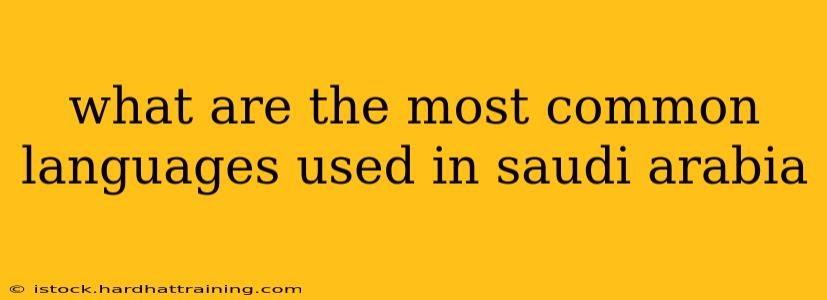Saudi Arabia, a land of rich history and vibrant culture, boasts a fascinating linguistic landscape. While Arabic reigns supreme, understanding the nuances of language use within the Kingdom reveals a more complex picture. This post delves into the most common languages spoken in Saudi Arabia, exploring their prevalence and significance in various contexts.
Arabic: The Official and Predominant Language
Arabic is the official language of Saudi Arabia and the lingua franca spoken by the vast majority of its population. More specifically, Modern Standard Arabic (MSA) is used in formal settings like government, education, and media. However, day-to-day conversations typically involve various dialects, most notably Najdi Arabic, spoken in the central Najd region, and Hejazi Arabic, prevalent in the western Hejaz region. These dialects differ significantly from MSA, showcasing the rich diversity within the Arabic language itself. Understanding these variations is crucial for anyone seeking a deeper understanding of Saudi Arabian society.
The Importance of Dialects
While MSA provides a unifying force across the nation, the local dialects hold significant cultural importance. They reflect regional identities, traditions, and social dynamics. For example, the nuances of Najdi Arabic might convey subtle differences in meaning or social standing that would be lost in translation to MSA. Therefore, mastering a specific dialect, particularly if interacting with local communities, significantly enhances communication and cultural understanding.
English: A Language of Growing Importance
English plays an increasingly significant role in Saudi Arabia's modern economy and society. Its prevalence is particularly notable in:
- Education: English is widely taught in schools and universities, often alongside Arabic, preparing students for higher education and global opportunities.
- Business: With a booming economy and strong international ties, English serves as a crucial language for business transactions, negotiations, and communication with international partners.
- Technology: The tech sector relies heavily on English for software development, online communication, and access to global information.
- Tourism: As the tourism sector expands, English is increasingly important for attracting and serving international visitors.
While not widely spoken as a first language, English proficiency is a valuable asset in Saudi Arabia, offering numerous professional and social advantages.
Other Languages: A Reflection of Diversity
While Arabic and English dominate, a small percentage of the population speaks other languages, primarily due to:
- Expatriate Communities: Saudi Arabia's diverse expatriate population introduces a wide array of languages, including Urdu, Hindi, Tagalog, Bengali, and many others, depending on the specific workforce sectors. These languages are largely used within specific communities.
- Historical Influences: Traces of other languages, though less prevalent today, may reflect past historical interactions and cultural exchanges.
Conclusion: Navigating the Linguistic Landscape
The linguistic landscape of Saudi Arabia is dynamic and multifaceted. While Arabic forms the bedrock of the nation's identity and communication, English is rapidly gaining importance in various sectors, highlighting the country's integration into the globalized world. Understanding the prevalence of these languages, as well as the nuances of regional dialects, is key to effectively navigating Saudi Arabian society and its vibrant cultural tapestry. Further research into specific dialects and their regional variations can provide even deeper insights into this rich linguistic landscape.
